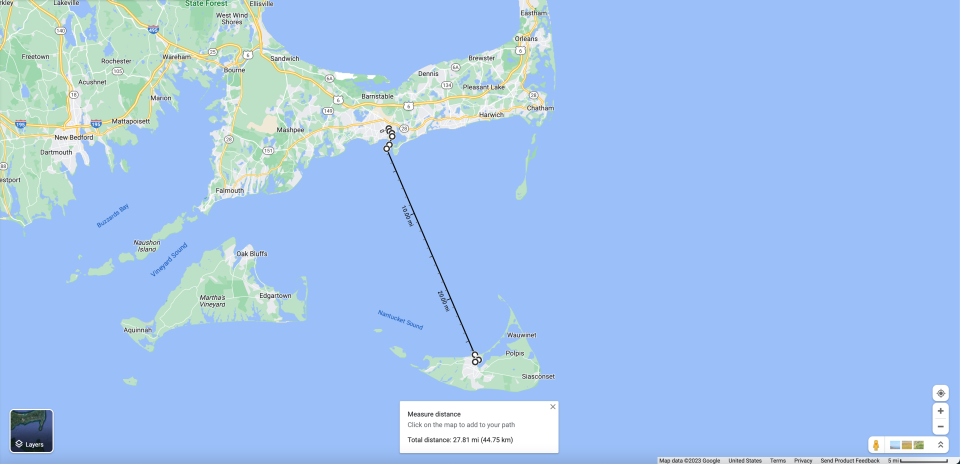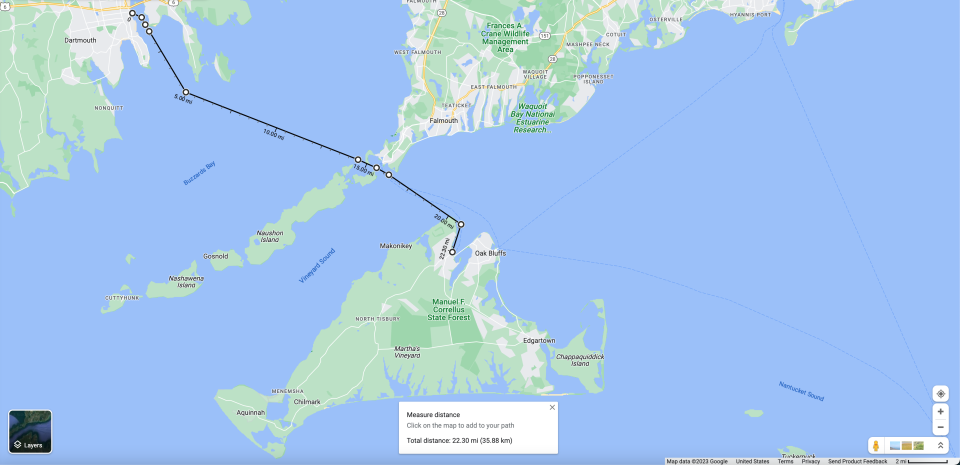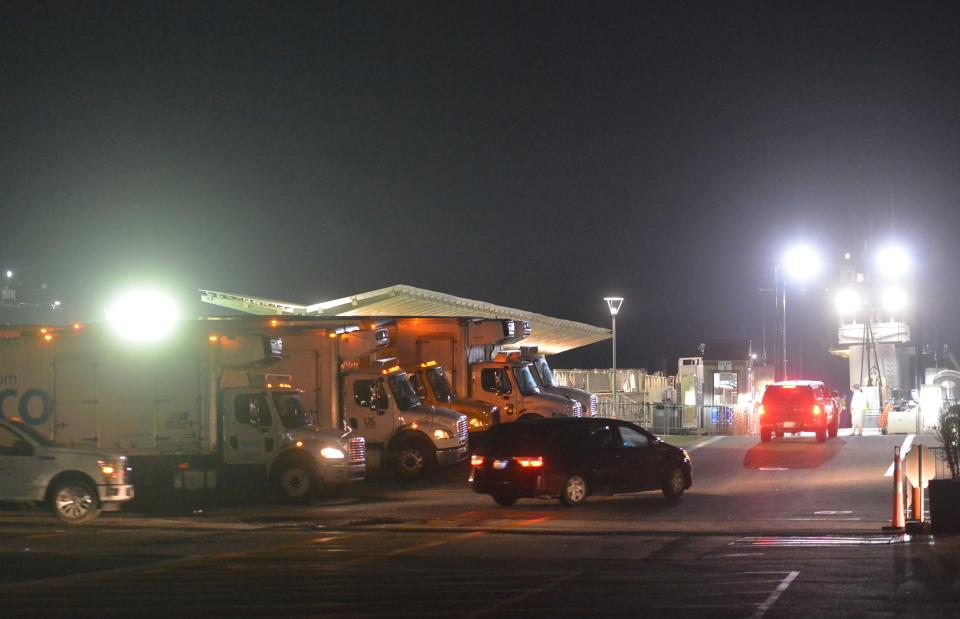'This is really ground zero here': Is Woods Hole too small for Steamship freight?
Before sunrise on Wednesday morning, the village of Woods Hole in the town of Falmouth is quiet, still and idyllic. The faint outline of wooden, Cape Cod-style architecture is visible up and down the main thoroughfare, aptly named Woods Hole Road.
But just as integral to the village as its quaint charm, Woods Hole hosts the main port for freight transportation to and from Martha’s Vineyard: the Woods Hole, Martha’s Vineyard and Nantucket Steamship Authority’s ferry terminal, the largest lifeline for food and supplies to the island.
As important as the port is to the Vineyard, the presence of the terminal comes at a cost to Cape residents who live in the vicinity. Dozens, sometimes upwards of 60 to 70 freight and delivery trucks per day, travel through the residential, two-lane corridor of Woods Hole Road.

Many come at dawn.
“Here comes a small convoy now,” said Woods Hole native Nat Trumbull at 5:09 a.m. outside the century-old fieldstone building of the Woods Hole Public Library.
Three freight trucks rumbled down Woods Hole Road toward the port, breaking the morning’s silence.
Trumbull, a professor of geography and maritime studies at the University of Connecticut, spearheads a community group, SMART, dedicated to raising awareness on issues of transportation and advocating for policy change in the southeastern region of Massachusetts. One of the group’s main concerns is the Woods Hole port.
A few minutes later, another convoy of trucks, this time two grocery store day cabs and one delivery truck, drove through the street and turned into the Steamship Authority lot to queue for the controversial 5:30 a.m. ferry to the Vineyard. Proponents say the early service is necessary to provide residents of the island with essentials — some residents of Woods Hole, on the other hand, say it makes sleeping past dawn difficult if not impossible.
“The rule, after years of complaining, was that they would not put trucks larger than 40 feet on the 5:30 boat, which was a good accommodation,” said Trumbull. “But these guys are still waking up people on this whole road, through the whole Falmouth corridor.”
Minutes after the second convoy, an unmistakable smell of garbage waste blanketed the air.
“Oh, that’s always nice,” Trumbull said mid-sentence once he noticed the odor. “There can be up to 13 trash trucks a day, basically all of the island’s trash comes off through Woods Hole, this is really ground zero here.”
Aside from sleep, several Woods Hole residents who spoke to the Times voiced concerns about the odor, as well as daily noise levels and the adverse health effects of living near an industrial area.
Director of Communications for the Steamship Authority Sean Driscoll said the Authority is not the only business or industry to affect the village. Municipal waste management services and restaurant delivery also add to the traffic and increased noise levels in the area.

“There's no way around that, that's just life, and we try our best to mitigate it while fulfilling our statutory duty to provide for the transportation of goods and services to the island at Martha's Vineyard,” he said. “This is the only way that that stuff can get there.”
Driscoll said the Authority has spent millions of dollars working with the town and residents to mitigate the impact of the port’s presence.
Pam Stark, a resident of Woods Hole whose home is a mere stone’s throw from the ferry terminal, was out for a morning walk at 6:30 a.m. when she told the Times she’d seen the village transform firsthand.
“I know I sound like a whiner,” Stark said. “It’s like when people say, ‘If you buy next to an airport, expect airplanes.’ But we’ve lived here for 26 years, and the increase in freight traffic has been astronomical.”
Truck traffic in Woods Hole for Steamship Authority business has increased over the years
Data provided by the Steamship Authority shows the number of vehicles, including trucks of all varieties, have increased over the past two decades. In 1998, the number of trucks ferried to and from the Vineyard was 39,411. Last year, that figure was 59,233.
Trucks 55 feet or greater, but less than 65 feet, were the most common type of truck ferried to and from the islands last year, according to Steamship Authority data obtained by the Times. These vehicles include garbage hauling trucks, aviation fuel trucks, gasoline trucks, heating oil trucks and propane trucks — among others. There were 16,884 vehicles of this type that traveled through the port of Woods Hole last year.
“I used to be able to go out to my yard, enjoy a little peace, but now it’s about every 15 or 20 minutes that the trucks come rumbling down,” said Stark, overlooking the Steamship Authority terminal on the Crane Street bridge. “It’s changed a lot.”
James Malkin, the representative from Dukes County on the Steamship Authority board, said Woods Hole was never a quiet village. He said it’s always been a busy, deep-water port used for a variety of industrial purposes.
As far back as 1815, Woods Hole was a hub for whaling, according to the National Oceanic and Atmospheric Administration. Then, in the 1860s, a thriving yet controversial guano industry began to flourish — shutting down in 1889, much to the relief of residents in the area who suffered from the strong odor of guano from the plant.
Presently, Malkin said, residents in port communities are experiencing the impact of a rapid population influx.
“And as I have said in meetings before, while I sympathize with everyone, including people in Hyannis, Woods Hole, Vineyard Haven and Nantucket, that's an issue of growth,” Malkin said. “The islands are sinking under the weight of money.”
Here's how Falmouth benefits from housing the Steamship Authority port.
Steamship Authority, Cape Cod and Island officials, as well as some residents, pointed to the economic benefits the port brings to both the town of Falmouth and the Vineyard.
Last year, nearly a quarter of the Steamship Authority’s workforce — about 175 employees — resided in Falmouth, said Peter Jeffrey, the representative from Falmouth on the Steamship Authority board.
“The largest percentage of the workforce lives in Falmouth, and that represented about $9.7 million in wages that went to town residents,” Jeffrey said.
There is also a fee associated with passenger embarkation at ports — set by state law — designed to create an additional revenue source for port towns, like Falmouth, to use to offset the adverse impact of Steamship Authority business in town.

“In the summer, with the Steamship and more people, public safety is a major issue,” said Falmouth Select Board Chair Nancy Taylor. “So, we use embarkation money to support our fire and rescue, and to support our police department.”
Taylor could not comment on the specifics of embarkation fee spending in Falmouth, adding the town manager has discretionary use of the funding. The office of the Falmouth town manager did not respond to several calls and emails from the Times.
Recently, state Sen. Julian Cyr, D-Truro, filed a bill that would raise the fee from its current rate of $.50 to $2. Cyr said in an interview on Wednesday the fee increase would help port communities defray additional costs, adding that the bill was filed at the request of Tisbury and Oak Bluffs Finance Committees.
If not Woods Hole, where else would a Steamship Authority port go?
Several residents who spoke to the Times, such as Trumbull, Stark and others, said they advocate for off-Cape solutions in order to cut down on Steamship Authority activity in the area. Many point to the Port of New Bedford as a viable option, which is closer to Martha’s Vineyard than Hyannis is to Nantucket, according to Google Maps.
Currently, the New Jersey-based Seastreak ferry service — licensed by the Steamship Authority — makes seasonal passenger trips to and from New Bedford and the Islands. According to Seastreak’s website, the average travel time to Martha’s Vineyard from New Bedford is an hour.

Ed DeWitt, a Woods Hole resident and former Steamship Authority board member, said he studied the New Bedford option when he was appointed to the town Transportation Management Committee, an advisory group to the Falmouth Select Board focused on innovative solutions to municipal transportation issues. He said New Bedford hosts a number of key infrastructure qualities, making it a suitable candidate for freight transportation.
“It's not the only option, but it certainly seems by far the best option,” DeWitt said. “You have the interstate highway, you have rail, you have a great harbor, and so it does make sense.”
New Bedford is too expensive, Authority representative says
Driscoll said the Authority has also studied this option, operating a one-year pilot program in 2000 and issuing a feasibility study in 2016 to conduct a thorough review of what it would look like to ship freight from New Bedford to the Vineyard. The study found the option financially impractical.
“We don't have a place to run operations from in New Bedford, the state pier is not able to support the weight of our trucks, and there's not a ton of ton of options in that area for us to be able to load and offload vessels, stage vehicles and have an operation,” he said.

In March of 2022, Driscoll said the Steamship Authority issued a public request to potential ferry services “seeking to conduct licensed freight operations between the port of New Bedford and Martha’s Vineyard.” He said they received zero proposals back.
“That (request for proposals) was very clear, very fair and flexible,” Driscoll said. “The fact that we got no potential proponents, I think, that speaks volumes.”
Moira Tierney, the representative from New Bedford on the Steamship Authority board, did not respond to several requests for comment from the Times.
A spokesperson for New Bedford Mayor Jon Mitchell said he was not available for an interview with the Times. But in an email Wednesday, Mitchell said the city is not ruling out the possibility of utilizing the port of New Bedford to transport Steamship Authority freight to and from the Islands.

“Despite the port’s continued success, we are always open to opportunities to diversify our maritime sector, including the introduction of additional freight lines, so long as they complement existing port businesses,” Mitchell said, referring to existing commercial interests such as fishing and offshore wind projects.
Gordon Carr, executive director of the Port of New Bedford, did not agree to an interview with the Times, saying he did not have anything further to add to the mayor’s comment.
As the morning rush of freight traffic began to slow down at around 7:00 a.m., Stark said the trucks would continue to trickle in throughout the day, with just as many vessels making their rounds in and out of the port — to and from the Vineyard.
“You can stand here and watch the vessels go out, with their diesel engines, and the black smoldering clouds that come out of their smokestacks. And, you know, in industrial areas, we all expect that. But these homes were here before the Steamship Authority and before the growth,” Stark said. “We’re not an industrial area, there has to be more responsibility, and all these things need to be addressed.”
Walker Armstrong reports on all things transportation and the Joint Base Cape Cod military base. Contact him at WArmstrong@gannett.com. Follow him on Twitter:@jd__walker.
Thanks to our subscribers, who help make this coverage possible. If you are not a subscriber, please consider supporting quality local journalism with a Cape Cod Times subscription. Here are our subscription plans.
This article originally appeared on Cape Cod Times: Steamship traffic at Woods Hole has multiplied. Is there a solution?

